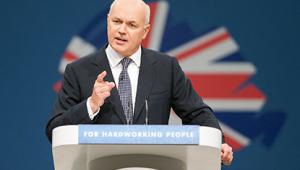By Vivienne Russell | 14 June 2012
The government wants to redefine the way it measures child poverty, Work and Pensions Secretary Iain Duncan Smith announced today.
Figures also published by his department today show the proportion of children in poverty fell by 2 percentage points between 2009/10 and 2010/11. But Duncan Smith said the statistics were not especially good news, and had been brought about by a drop in median income, against which relative poverty is measured.
‘In 2010/11 the economic downturn brought with it the largest drop in median income since 1980, dragging the relative poverty threshold down with it. But even as relative poverty fell, absolute poverty remained flat at 11%,’ he said in a speech.
‘These figures make the powerful point that while some families may have crossed an arbitrary threshold, real incomes did not rise and the lives of the poorest did not change. How perverse that the simplest way of reducing child poverty is to collapse the economy.’
Duncan Smith said that, in the autumn, the government would be consulting on how best to measure child poverty, saying the current approach was too narrow. Other indicators could include problems such as drug addiction or chronic worklessness in families. Simply increasing the incomes of such families did nothing to address the causes of their poverty, he said, and could even intensify problems.
‘What today’s figures make clear is that as the years roll by, the “poverty plus a pound” approach did not do enough to transform the lives of those in need,’ the work and pensions secretary said. ‘Moving someone from one pound below the poverty line to one pound above it might be enough to hit a target. But what about the people stuck at the very bottom?'
The latest child poverty figures show that, in 2010/11, 2.3 million (18%) UK children were living in households with incomes below 60% of median levels. After housing costs were deducted, the number rose to 3.6 million (27%).
Compared with 2009/10, this represents a fall of 2 percentage points both before and after housing costs.Compared with 1998/99, it is a 9 percentage point (1.1 million) fall before housing costs, and a 7 percentage point (0.9m) fall after housing costs.
Alison Garnham, chief executive of the Child Poverty Action Group, urged the government to remain focused on the goal to eliminate child poverty.
She said: ‘We welcome the coalition’s commitment to keeping the income targets and agree that any new ways of measuring child poverty should supplement what we have, rather than move the goal posts.
‘We should look at how targets could drive progress in areas like social housing supply, living wage jobs, youth employment and affordable childcare. If we create more jobs, pay fair wages and drive up the supply of affordable homes, we can drive down child poverty at a faster pace and control the welfare budget without hacking holes in the safety net.’
Nick Pearce, director of the Institute for Public Policy Research, said it would be wrong to think that child poverty fell just because of a drop in median income. He said a 2.9% uprating in the child element of the Child Tax Credit in 2010/11 had increased the incomes of families with children, particularly those on lower incomes.
‘Given the fiscal position, ministers should now focus resources on three clear priorities: ensuring under-fives don’t live in poverty, building a universal childcare system, and enabling families who work to leave behind the curse of poverty,’ Pearce said.
He added that there were now more children living in poverty in households where one of the parents works than in workless households. ‘Low-income families can do all the right things – hold down jobs and raise their children as best they can – and still be poor if they can’t earn a decent living.’





















